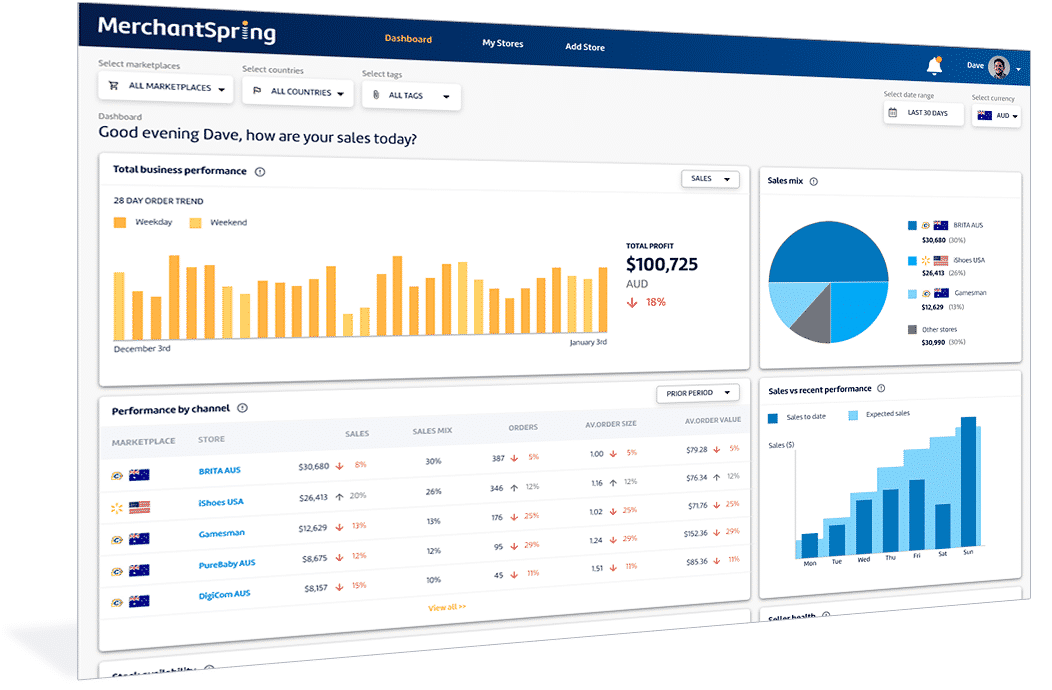Pods, People & Proactivity: Account Management Strategies That Scale
Overview
Scaling an Amazon agency without rockstar account management is like trying to build a skyscraper on sand. Account managers are the foundation of client success – and when that foundation is weak, growth collapses. In a recent Marketplace Masters episode, industry veteran Scott Ohsman, VP of Digital Commerce at Quickfire, dropped hard truths about what great Amazon account management really looks like and how to scale it. With over 30 years in e-commerce (having launched 200+ brands on Amazon), Ohsman’s perspective is both expert and battle-tested. The takeaway? If your agency isn’t proactively driving client outcomes and anticipating problems before they escalate, you’re already behind.
The Three Pillars of Elite Account Management
“You can’t reason with crazy. But you can bury it in proactive execution.” – Scott Ohsman, Quickfire VP
According to Ohsman, elite Amazon account managers live by three core principles:
- Answer Questions Before They’re Asked. Great account management isn’t reactive – it’s preemptive. The best agencies anticipate client needs and surface insights before the client even knows there’s an issue. This means setting up the right monitoring processes, analytics, and communication cadence so you’re always a step ahead. Did sales dip overnight? A proactive account manager will have a root-cause analysis and action plan ready before the client calls. By answering questions that haven’t even been voiced yet, you build immense trust and prove your value daily.
- Drive the Business Relentlessly. “You’re not just managing accounts – you’re owning outcomes,” Ohsman says. In other words, act like your client’s business is your own. Great account managers constantly look for ways to drive growth and efficiency: expanding profitable product lines, tweaking Amazon ad strategy, improving content and conversion, monitoring inventory and profit margins – the works. This entrepreneurial mindset means using every tool in the Amazon playbook (assortment, pricing, advertising, operational fixes, etc.) to push the business forward. By thinking like a brand operator rather than a service provider, you don’t just report results – you engineer them.
- Make Offense Your Best Defense. When a client is unhappy or hypercritical, many agencies fall into a defensive crouch – but not the great ones. Ohsman’s approach to “difficult” clients is counterintuitive but effective: flood them with value. That means over-communicate and over-deliver. Send frequent updates, extra reports, and clear strategies addressing every concern. If a client emails after hours with a worry, your team is already drafting a data-backed response (though do set boundaries – more on that later). By aggressively demonstrating that you’re on top of things, you leave no room for doubt. As Ohsman puts it, an onslaught of proactivity can even turn around the “crazy” situations – when done right, even the toughest clients will recalibrate their tone and trust you again.
These three pillars boil down to one theme: be proactive, not reactive. Agencies that internalise this will find their client relationships far smoother and more profitable.
Structure Is the Secret to Scaling
Even the best account manager will struggle to shine in a dysfunctional setup. As your agency grows, structure isn’t optional – it’s survival. Ohsman warns that agencies which scale without a solid team structure and process are “flirting with failure.” So what does the right structure look like?
- Build Pod Teams for Big Growth: Past a certain client count, the classic one-AM-does-it-all model falls apart. Ohsman insists that a pod structure – a dedicated, cross-functional team for each client or client group – becomes non-negotiable once you scale up. In a pod, an Account Manager leads a small supporting cast (ad specialist, operations/logistics coordinator, creative or finance support, etc.), all focused on a subset of clients.
This modular approach keeps quality high as you add more clients, because each pod can only handle a fixed load. In fact, agency consultants note it’s nearly impossible to profitably manage 50+ clients without a pod structure – you’ll overstretch your people and service quality will nosedive(sakasandcompany.com). By contrast, pods let you add capacity per unit of growth, like stacking sturdy building blocks as your agency rises. - Match Resources to Client Complexity: Not all accounts are created equal, so don’t staff them as if they are. A common mistake is assigning accounts purely by revenue or simply saying, “Jane has 5 accounts, she can take 2 more.” That’s a recipe for burnout and margin suicide, as Ohsman bluntly puts it. Instead, evaluate each client’s complexity and needs. How deep is their catalogue (hundreds of SKUs or a lean 5-product line)? Is it 1P, 3P, or hybrid? Do they run heavy Amazon Ads spend (and require advanced DSP or OTT ads management) or just basic campaigns? How competitive is their category? Do they have external traffic and a strong D2C game, or are they relying entirely on Amazon?
A high-touch client with messy logistics and aggressive growth goals might require one full pod’s attention by itself, whereas a portfolio of a few smaller, stable brands could comfortably sit with a single pod. By factoring in SKU count, sales velocity concentration, fulfillment model, ad sophistication, off-Amazon marketing, and even the client’s internal responsiveness, you can assign the right team and prevent overloading your stars. - Watch the Profitability (and Don’t Overload the A-Players): As you shift to pods, keep an eye on your margins per pod. It can be tempting to cram many clients under one team to save costs, but if that team can’t maintain quality service, you’ll pay the price in churn (and burned-out staff). Do the margin analysis to know when a pod is at capacity and when it’s time to invest in another hire or a new pod. This also ties into client mix: too many low-revenue accounts can be as draining as one huge, demanding account that underpays. Strive for balance. Remember: happy account managers lead to happy clients, which leads to a healthy bottom line.
- Onshore vs. Offshore Talent – Use What Works: To scale efficiently, many agencies leverage offshore team members for support roles (catalogue management, reporting, design, etc.). Ohsman’s take is pragmatic: great talent is great talent, wherever it’s located. The key is to have the right people and clear processes. If an offshore support team in the Philippines or India helps you provide 24/7 coverage and cost-effective service, that can be a huge win – as long as communication is tight and quality is maintained.
Plenty of top agencies use hybrid teams where senior client-facing strategists are onshore and execution specialists offshore. Ultimately, the goal is a well-oiled team that delivers results, not a particular org chart. Don’t be afraid to tap into global talent pools to find the skills you need to scale, especially for tasks that can be standardised or handled asynchronously. Just ensure those team members are integrated into your pods and empowered to contribute.
Prioritise People: Prevent Burnout and Turnover
Account management is often cited as one of the toughest jobs in an agency. It demands a rare mix of analytical acumen, relationship-building skills, project management, and constant context-switching – all at the breakneck speed of Amazon’s marketplace. It’s no surprise that burnout and turnover among account managers can run high, which is deadly for an agency’s stability(blog.uncommonlogic.com). Ohsman emphasises that keeping your team motivated, supported, and sane is just as important as hitting client KPIs. Here’s how to cultivate a culture that retains top talent and keeps them performing at their best:
- Set Boundaries and Train Your Clients. A healthy work-life balance isn’t just good for your team – it’s good for clients in the long run, because it prevents burnout (which would hurt service quality). “The moment your AM replies to a 11pm or weekend client message, you’ve lost,” Ohsman says. It trains the client to expect round-the-clock instant responses, which is unsustainable. Instead, establish expectations early in the relationship.
Let clients know your communication hours and hold that line. Of course, being proactive and responsive during business hours is crucial – but your team shouldn’t feel enslaved to their phones 24/7. By training clients to respect boundaries, you actually foster more professional, trusting partnerships. Most reasonable clients understand that a fresh, focused team will do better work than an exhausted one. - “Glads and Sads” Check-ins. Forget the perfunctory corporate one-on-one meeting – Ohsman advocates a simple, candid approach to team check-ins. Ask each team member to share three things they’re glad about, three things they’re sad about, and what they’d change if they could. Then you do the same as a leader. These quick “Glads and Sads” sessions create space for honesty about frustrations and wins. Maybe an AM is glad about how a client’s launch performed, but sad about consistently unrealistic client deadlines.
Such insights are pure gold – they let management address issues before people get fed up and leave. The casual but sincere format bypasses the awkwardness of formal reviews and gets straight to what matters. By actively listening and acting on your team’s feedback, you’ll improve morale and show your account managers that you truly value them. - Reward Retention and Client Success. To keep star account managers, structure your incentives accordingly. Consider linking part of compensation or bonuses to client retention and satisfaction metrics. When an AM knows that growing a client’s business and keeping them happy directly ties to a personal reward, they’ll feel ownership and pride in that success. (Just be careful to acknowledge when churn is beyond their control – e.g. a client’s company gets acquired – so it’s fair.)
Moreover, celebrate the qualitative wins too: a glowing client email about an AM’s great work should be shared and applauded company-wide. Make your team feel like the heroes they are when they delight a client or hit a tough goal. As the saying goes, take care of your employees and they will take care of your clients. - Cultivate a Supportive Team Culture. Agency life is a rollercoaster. Tight deadlines, Amazon quirks, demanding clients – it can be stressful even on good days. That’s why Ohsman believes in building a team culture where people have each other’s backs. Encourage account managers to share challenges and solutions with each other (a weekly huddle to swap tips or war stories can help everyone feel less alone in tackling issues).
Pair up newer account managers with veteran mentors who can guide them through the learning curve. And ensure your pods don’t become silos: rotate wins and lessons learned across teams. When your account managers feel supported by their peers and cared for by leadership, even the craziest days become manageable.
Remember, burnout is the silent killer of agencies. A single overworked AM quitting can send clients (and other team members) into panic mode. By investing in your people – through smart workload planning, boundaries, open communication, and recognition – you build an engine for long-term agency growth. As Ohsman highlights, people are your most important asset in the services business. Treat them well, and they’ll take your agency to new heights.
Conclusion & Next Steps
Amazon account management may be a “constant balancing act” – but with the right best practices, you can keep that balance and scale it, too. From proactive client management and a structured pod team model to a client-centric yet sustainable culture for your team, these insights from Scott Ohsman can transform how your agency operates. The core message is clear: great account management is proactive, data-driven, and intensely people-focused. If you embed these principles in your agency’s DNA, you’ll not only delight your clients with better results and service – you’ll also create an environment where your team can thrive alongside your growing client roster.
🔔 Want to learn more? This blog barely scratches the surface of the actionable tips shared. Be sure to watch the full webinar on demand in our Marketplace Masters video library for deeper insights and examples.
Optimise Your Agency’s Account Management with MerchantSpring: To scale effectively, your team needs the right tools. MerchantSpring’s platform equips Amazon agencies with real-time analytics, automated reporting, and multi-marketplace visibility – so your account managers can spot issues before your clients do and seize growth opportunities faster.
Don’t let data blind spots or manual reporting hold your team back. Book a MerchantSpring demo today and see how we can help you deliver the proactive, high-impact account management that keeps clients loyal and builds your reputation as a top-tier Amazon agency.


-Jul-10-2025-11-04-53-5475-PM.png)











Add a Comment